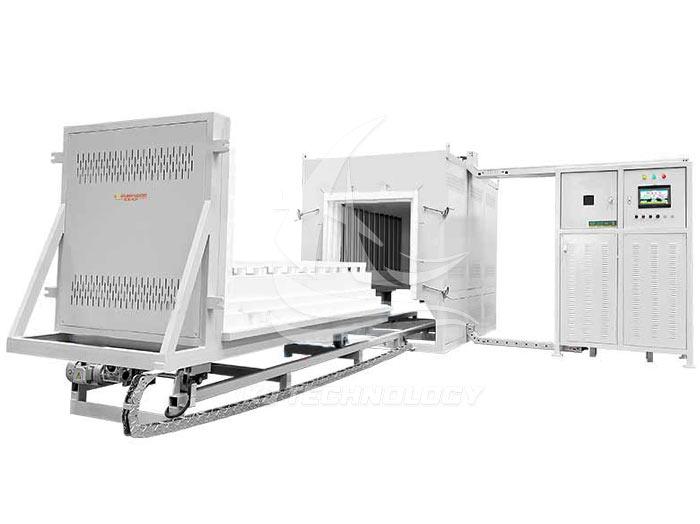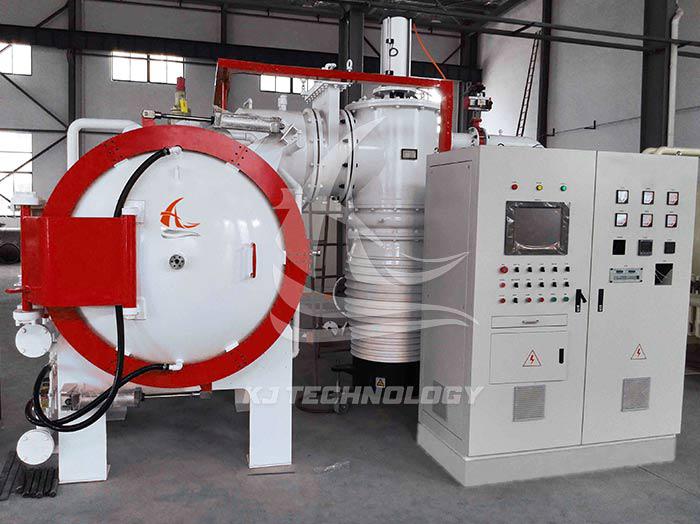Gas quenching furnace
 10-27-2025 Author: KJ technology
10-27-2025 Author: KJ technology
Gas quenching furnace is a heat treatment equipment that achieves rapid cooling of metal materials through high-pressure gas circulation flow. It is widely used in aerospace, precision manufacturing and other fields. Its core principles, technical parameters, structural characteristics and process advantages are as follows:
1. Core principle
The gas quenching furnace achieves rapid cooling of metal workpieces by circulating high-pressure gases (such as nitrogen and helium) inside the sealed furnace. Its workflow is divided into three stages:
Vacuum heating: Heat the workpiece to the quenching temperature in a vacuum environment to avoid oxidation.
Gas filling and circulation: Fill high-pressure gas into the furnace, start the fan to circulate the gas, and cool the gas through a heat exchanger.
Quenching cooling: The cooled gas is evenly supplied to the surface of the workpiece through an air duct, achieving rapid cooling.
Compared with liquid quenching, gas quenching has no phase transformation process, more uniform heat transfer, can significantly reduce workpiece deformation, and there is no residual medium on the surface of the workpiece after quenching, which does not require cleaning.
2. Technical parameters
The core parameters of a gas quenching furnace include:
Maximum operating temperature: up to 1300 ℃, meeting the solid solution treatment requirements of materials such as nickel based alloys and titanium alloys.
Ultimate vacuum degree: ≤ 5 × 10 ⁻ ³ Pa (high vacuum environment), ensuring zero oxidation conditions during material processing.
Quenching pressure: Supports a maximum of 10 bar (some equipment can reach 40 bar), and the quenching strength is controlled by adjusting the gas pressure.
Effective processing space: Depending on the device model, the effective processing length can reach 3000mm, which can accommodate large workpieces or batch processing of multiple workpieces.
Uniformity of temperature field: ≤± 5 ℃, meeting the requirements of precision heat treatment process.
3. Structural characteristics
The structural design of gas quenching furnaces focuses on high efficiency, stability, and easy maintenance:
Heating chamber:
Adopting a stainless steel skeleton and a new type of carbon felt composite material, it is resistant to high temperature and high pressure airflow erosion, with minimal deformation and long service life.
The heating element is made of graphite tube or molybdenum alloy radiation heater, which is easy to install and maintain, and has a low failure rate.
The all metal structure heating chamber can meet the solid solution treatment requirements of titanium alloys and precision alloys.
Air cooling system:
Adopting jet cooling method, graphite nozzles are evenly distributed around the circumference, making the high-pressure airflow flow more reasonable.
The air volume of some main air ducts can be adjusted, and customers can control the air volume according to the characteristics of the workpiece, effectively controlling the deformation of the workpiece.
Equipped with high-speed, high-pressure, and high flow fans and copper copper high-efficiency circular heat exchangers to achieve high-speed cooling.
The fan can be controlled by single speed, dual speed, and variable frequency speed regulation to regulate the air cooling speed.
Electric control system:
Adopting PLC and programmable temperature controller, it realizes three control modes: fully automatic, semi-automatic, and manual, with flexible operation.
Equipped with multi-level temperature control program, supporting gradient temperature rise and fall process curve setting.
Integrated touch screen enables digital management of process parameters.
4. Technological advantages
Compared to traditional heat treatment equipment, gas quenching furnaces have the following significant advantages:
Reduce deformation: Gas cooling has no phase transition process, uniform heat transfer, which can significantly reduce workpiece deformation and avoid hard processing steps.
Process flexibility: By adjusting the gas pressure and gas velocity, the quenching strength can be adjusted according to the requirements of the parts.
Clean and non-toxic: After quenching, there is no residual medium on the surface of the workpiece, which does not require cleaning and meets the needs of further processing steps (such as coating).
Integrated production: It can be integrated into the production line to achieve mass production and improve production efficiency.
Reproducibility: The quenching results are stable and reliable, avoiding human error and ensuring product quality consistency.
5. Application Fields
Gas quenching furnaces are mainly developed for high-end alloy materials in the aerospace and precision manufacturing fields, with specific applications including:
Nickel based high-temperature alloys: solid solution strengthening treatment to eliminate casting segregation defects.
Titanium alloy: Heat treatment in the beta phase zone, controlling the precipitation morphology of the alpha phase through rapid gas quenching.
Cobalt based wear-resistant alloy: achieving uniform dispersion distribution of carbides.
Other alloy materials, such as stainless steel, mold steel, etc., meet their precision heat treatment requirements.








